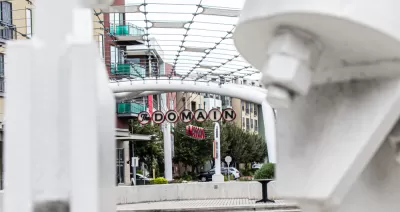A zoning change has increase height limits from 308 feet to 420 feet for new buildings near the city’s MLS stadium.

The Austin City Council recently approved a zoning change that will allow taller buildings in the neighborhood surrounding Q2 Stadium, home to the Austin FC Major League Soccer team.
“City Council approved a zoning change on Oct. 27 to allow buildings up to 420 feet in height – about 40 stories – on some properties around Q2 Stadium and in the Domain,” reports Jonathan Lee for the Austin Monitor. Councilmember Leslie Pool, who represents the area, is quoted in the article saying the zoning change will take advantage of an economic boom taking place in the area around the stadium.
“The Domain and surrounding area has seen as much new development as anywhere in Austin in recent years. Uptown ATX, a massive mixed-use development on IBM’s former campus, began construction last year, and several projects around Q2 Stadium are in various stages of development,” reports Lee.
“The height increase applies to buildings within the Commercial Mixed-Use (CMU) Gateway Zone subdistrict of the North Burnet Gateway Regulating Plan. Height in the zoning district was 308 feet before the change. Floor area ratio, a measure of density, also increased from 8:1 to 12:1.”
Councilmember Pool has also suggested that the entire North Burnet Gateway Regulating Plan is due for a complete update to prepare for incoming development interest and transit investments.
FULL STORY: Buildings over 400 feet tall now allowed around Q2 Stadium

Alabama: Trump Terminates Settlements for Black Communities Harmed By Raw Sewage
Trump deemed the landmark civil rights agreement “illegal DEI and environmental justice policy.”

Planetizen Federal Action Tracker
A weekly monitor of how Trump’s orders and actions are impacting planners and planning in America.

The 120 Year Old Tiny Home Villages That Sheltered San Francisco’s Earthquake Refugees
More than a century ago, San Francisco mobilized to house thousands of residents displaced by the 1906 earthquake. Could their strategy offer a model for the present?

Indy Neighborhood Group Builds Temporary Multi-Use Path
Community members, aided in part by funding from the city, repurposed a vehicle lane to create a protected bike and pedestrian path for the summer season.

Congestion Pricing Drops Holland Tunnel Delays by 65 Percent
New York City’s contentious tolling program has yielded improved traffic and roughly $100 million in revenue for the MTA.

In Both Crashes and Crime, Public Transportation is Far Safer than Driving
Contrary to popular assumptions, public transportation has far lower crash and crime rates than automobile travel. For safer communities, improve and encourage transit travel.
Urban Design for Planners 1: Software Tools
This six-course series explores essential urban design concepts using open source software and equips planners with the tools they need to participate fully in the urban design process.
Planning for Universal Design
Learn the tools for implementing Universal Design in planning regulations.
Clanton & Associates, Inc.
Jessamine County Fiscal Court
Institute for Housing and Urban Development Studies (IHS)
City of Grandview
Harvard GSD Executive Education
Toledo-Lucas County Plan Commissions
Salt Lake City
NYU Wagner Graduate School of Public Service





























